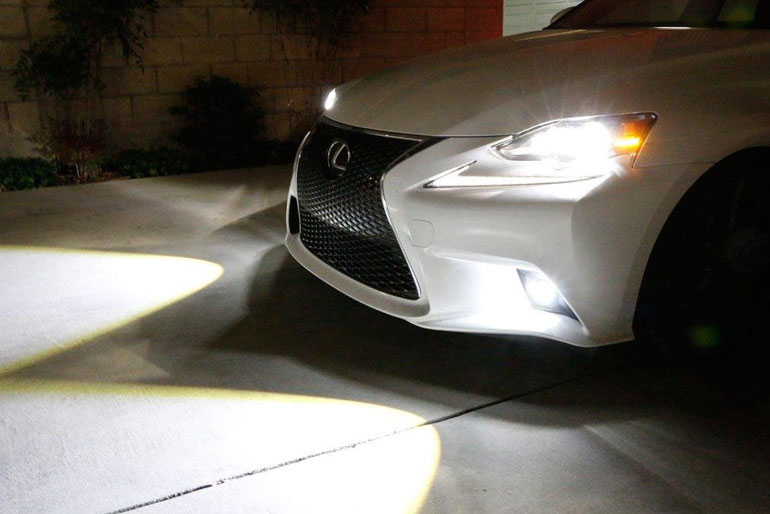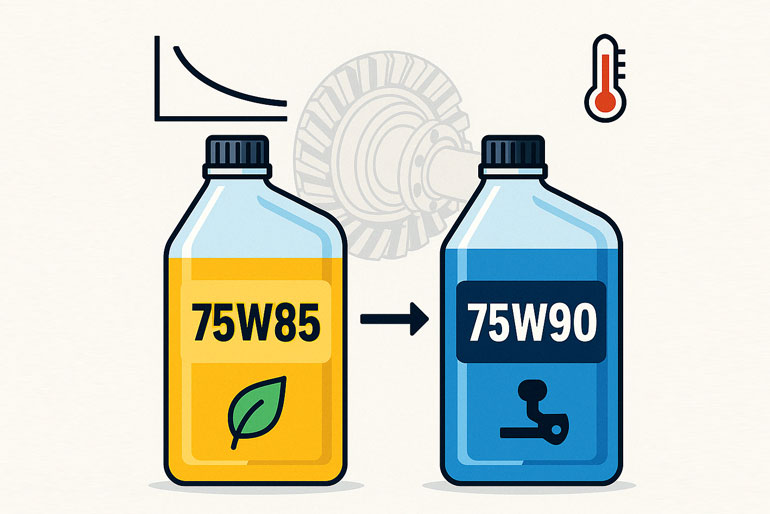Gear lube isn’t glamorous, yet the right choice keeps axles quiet, differentials cool, and drivetrains alive for the long haul. Two weights—75W85 and 75W90—often appear side‑by‑side on parts‑store shelves. Which bottle belongs in your vehicle? Let’s walk through the differences, benefits, and best‑use scenarios in everyday language.
Why the Numbers Matter
Motor oil grades look like 10W‑30 or 5W‑40; gear oils follow the same idea, just with bigger numbers because they’re naturally thicker. The format “75W90” breaks into two parts:
- 75W – How easily the oil flows when cold (the W stands for winter).
- 90 – How the oil behaves once everything is fully warmed up.
A lower winter number means easier flow on chilly mornings; a higher hot number means a thicker protective film under heavy load. Gearboxes, transfer cases, and differentials rely on that film to keep metal parts from grinding.
75W85 and 75W90 at a Glance
Both grades use the same 75W cold rating, so they move through bearings, gears, and seals equally well at start‑up temperatures. The change appears in the second number:
| Grade | Hot Viscosity (100 °C) | Typical Uses |
|---|---|---|
| 75W85 | ~14 cSt (centistokes) | Modern cars, light trucks aiming for fuel economy and tight tolerances |
| 75W90 | ~16 cSt | SUVs, pickups, performance cars, off‑road rigs, towing applications |
(Values are rough midpoints from various brand datasheets.)
The gap—about 2 cSt—looks tiny on paper yet translates to a noticeably thicker film inside a screaming differential spinning at highway speed.
Cold‑Flow Performance: A Tie
Since both bottles start with 75W, they must pass the same cold‑cranking test. In Arctic‑level weather either oil will pour, splash, and coat gear teeth quickly enough to prevent damage during those first few seconds of rotation. If you live where frost bites hard, the deciding factor isn’t winter viscosity—it’s the second number and how you drive once everything heats up.
Heat Protection and Shear Stability
What Happens Under Load
Differentials convert engine torque into wheel torque, pushing heavy hypoid gears sideways against each other. That sliding action tries to squeeze the oil layer out, a process called shear. When the oil film thins too much, metallic contact follows, leading to chattering noises, pitted gears, and eventually expensive repairs.
75W85
- Slightly thinner film when hot
- Lower drag, which can help incremental fuel economy in commuter cars
- Adequate for passenger vehicles that rarely tow, race, or crawl across boulders
75W90
- Thicker film, so it hangs on better when temperatures climb past 150 °C on uphill interstate pulls
- Resists shear under rapid acceleration or continuous off‑road crawling
- Preferred by many automakers for heavy‑duty axles, limited‑slip differentials, and performance models
If you regularly haul construction tools, hitch up a boat, or blast around winding mountain roads, 75W90 provides a bigger margin of safety.
Additive Packages: More Than Just Thickness
Viscosity is half the story. Gear oils carry extreme‑pressure (EP) additives—usually sulfur‑phosphorus compounds—that bond to metal surfaces and form a sacrificial layer when loads spike. Reputable brands tune those additives to each grade, meaning a premium 75W85 can out‑protect a bargain 75W90 if the cheaper product skimps on chemistry. Always pick a bottle that meets (substitute wording: satisfies) the API GL‑4 or GL‑5 specification your vehicle demands.
Fuel Economy: Small but Real Gains
Automakers chase every fraction of a kilometer per litre to satisfy government regulations and customer wallets. Shaving viscosity from 16 cSt to 14 cSt lowers churning losses inside the axle housing. In controlled tests, that change can yield roughly 0.1–0.5 percent better fuel efficiency. For a compact sedan driving 20,000 km a year, the savings may equal a tank or two of fuel annually. It’s not earth‑shattering, yet manufacturers multiply that figure across millions of cars.
Seal Compatibility and Aging
Modern synthetic gear oils include conditioners to keep rubber and silicone seals flexible. Both grades share similar additive blends, so switching between them rarely causes leaks. The bigger threat is extended drain intervals:
- 75W85 may shear slightly faster under extreme heat, shortening its service life if you’re towing.
- 75W90 holds viscosity longer, especially in axles without coolers.
Check your owner’s manual; typical change intervals run 60,000–100,000 km. Severe‑duty driving—towing a camper through midsummer deserts—calls for shorter intervals regardless of grade.
OEM Examples in the Real World
- Hyundai / Kia—Many front‑wheel‑drive models specify API GL‑5 75W85 to optimize mileage.
- Toyota—Late‑model trucks list 75W85 for the front differential and 75W90 for the rear to handle higher rear‑axle loads.
- Ford Super Duty—Rear axles arrive from the factory filled with 75W90 or even 75W140 on heavy‑tow packages.
- Jeep Wrangler Rubicon—Using 75W90 is mandatory because the Dana 44 locker experiences steep shock loads on the trail.
These examples illustrate that engineers match viscosity to the stresses each axle faces, not to brand preference.
When 75W85 Makes Perfect Sense
- Daily commuting in temperate climates
- Eco‑friendly focus where every drop of fuel counts
- Newer vehicles with tight gear tolerances designed around lower‑viscosity oils
- Warranty compliance if the handbook strictly lists 75W85 (always follow it while under warranty)
When 75W90 Is the Smarter Choice
- Towing trailers or carrying heavy payloads
- High‑performance driving, autocrossing, or spirited mountain runs
- Off‑road adventures where wheels spin against rocks, multiplying torque shocks
- Hot climates that keep axle temperatures elevated for hours
- Older vehicles built before automakers leaned into fuel‑economy standards
Mixing or Switching: Is It Safe?
Pouring 75W90 into a system that held 75W85 won’t cause immediate harm, and vice versa, because both belong to the same additive family. Still, mixing dilutes each oil’s carefully balanced chemistry, so a complete change is smarter than topping off with a different grade.
If you decide to switch:
- Drain fully while the gear oil is warm; it flows out faster and carries sludge with it.
- Flush (optional) by adding a small amount of fresh oil, spinning the wheels for a minute on jack stands, and draining again.
- Refill slowly, allowing air to escape and preventing pockets.
- Check level after a short test drive; expanding oil can burp trapped air.
Cost Difference at the Counter
Prices fluctuate, but synthetic 75W85 and 75W90 from the same brand often sit within a dollar or two of each other per litre. Because differentials take just 1.0‑2.5 L of fluid, the entire service rarely exceeds the cost of a casual lunch. Skimping on quality oil to save loose change risks a repair bill in the four‑digit range.
DIY Tips for a Clean Change
- Warm up by driving 10 km first; hot oil drains quicker.
- Use a hand pump to push new oil into cramped filler holes.
- Replace crush washers on drain and fill plugs to avoid drips.
- Wear gloves; EP additives have a strong sulfur scent that sticks to skin.
- Capture used oil in a sealed jug and recycle responsibly—most auto‑parts stores accept it for free.
Frequently Asked Questions
Q: My manual lists 75W85 GL‑5. Can I upgrade to synthetic 75W90?
A: “Upgrade” isn’t always the right word. Synthetic 75W90 may protect better under severe load, but if fuel economy and warranty compliance matter most, stick with 75W85.
Q: Is 80W90 the same as 75W90?
A: Both share a 90 hot rating, yet 80W cold flow is thicker than 75W. In icy regions, 75W grades reach critical parts faster.
Q: Do limited‑slip differentials need a special additive?
A: Many modern synthetic gear oils already include friction modifiers. If your LSD chatters around corners after a change, add the manufacturer’s recommended modifier.
Q: How can I tell when it’s time to change gear oil?
A: Look for dark color, burnt odor, or metallic glitter during inspection. Absent signs, follow the interval in your service schedule.
Final Thoughts
Choosing between 75W85 and 75W90 isn’t complicated once you focus on driving habits and manufacturer guidance. If your car’s handbook calls for 75W85 and you mostly cruise to work, that lighter grade reduces drag without sacrificing protection. If you tow, race, or explore dusty backroads, the thicker safety net of 75W90 is cheap insurance. Either way, selecting a trusted synthetic formula, changing it at sensible intervals, and installing it properly will reward you with a quiet axle and years of trouble‑free service—no technical jargon required.







